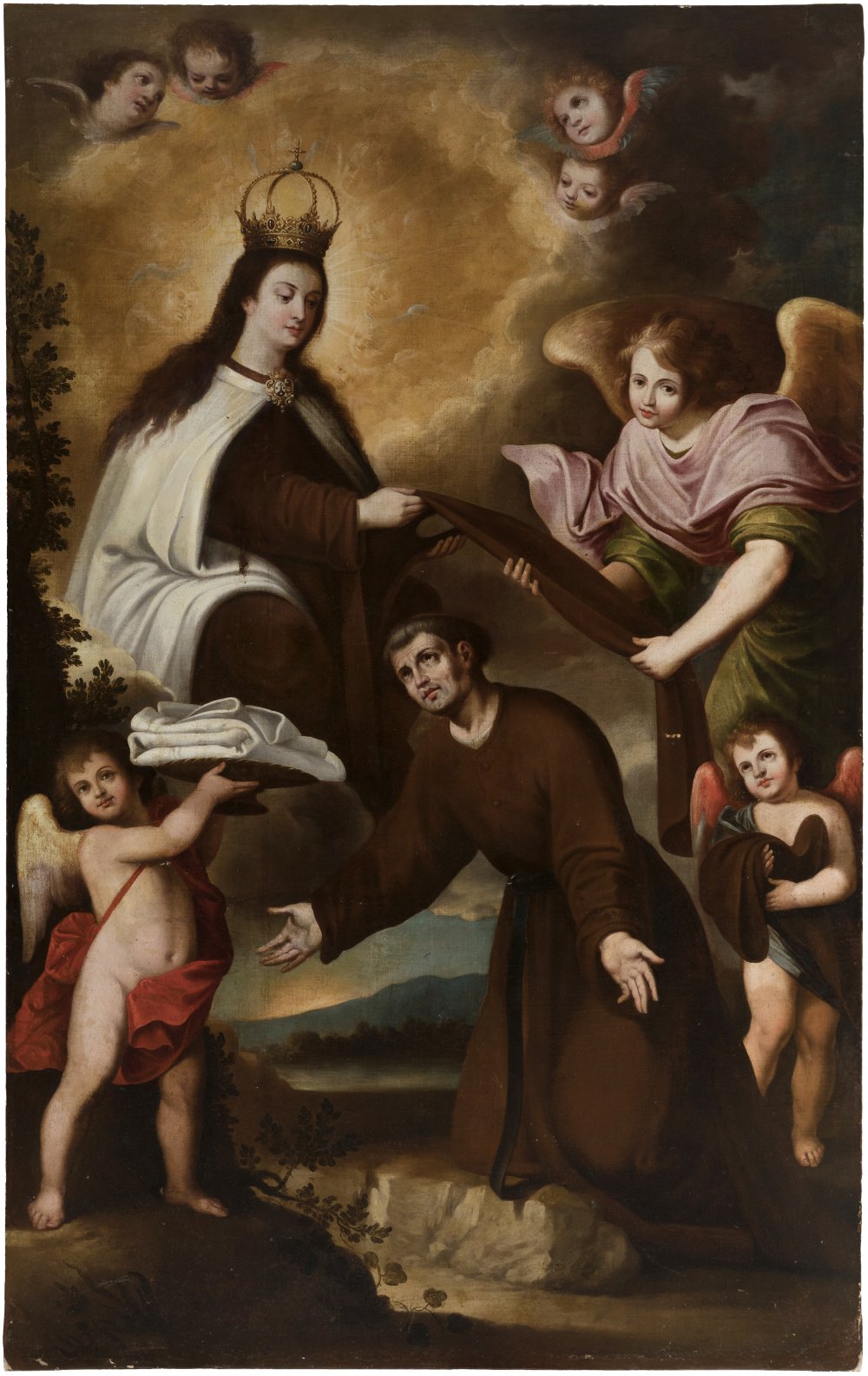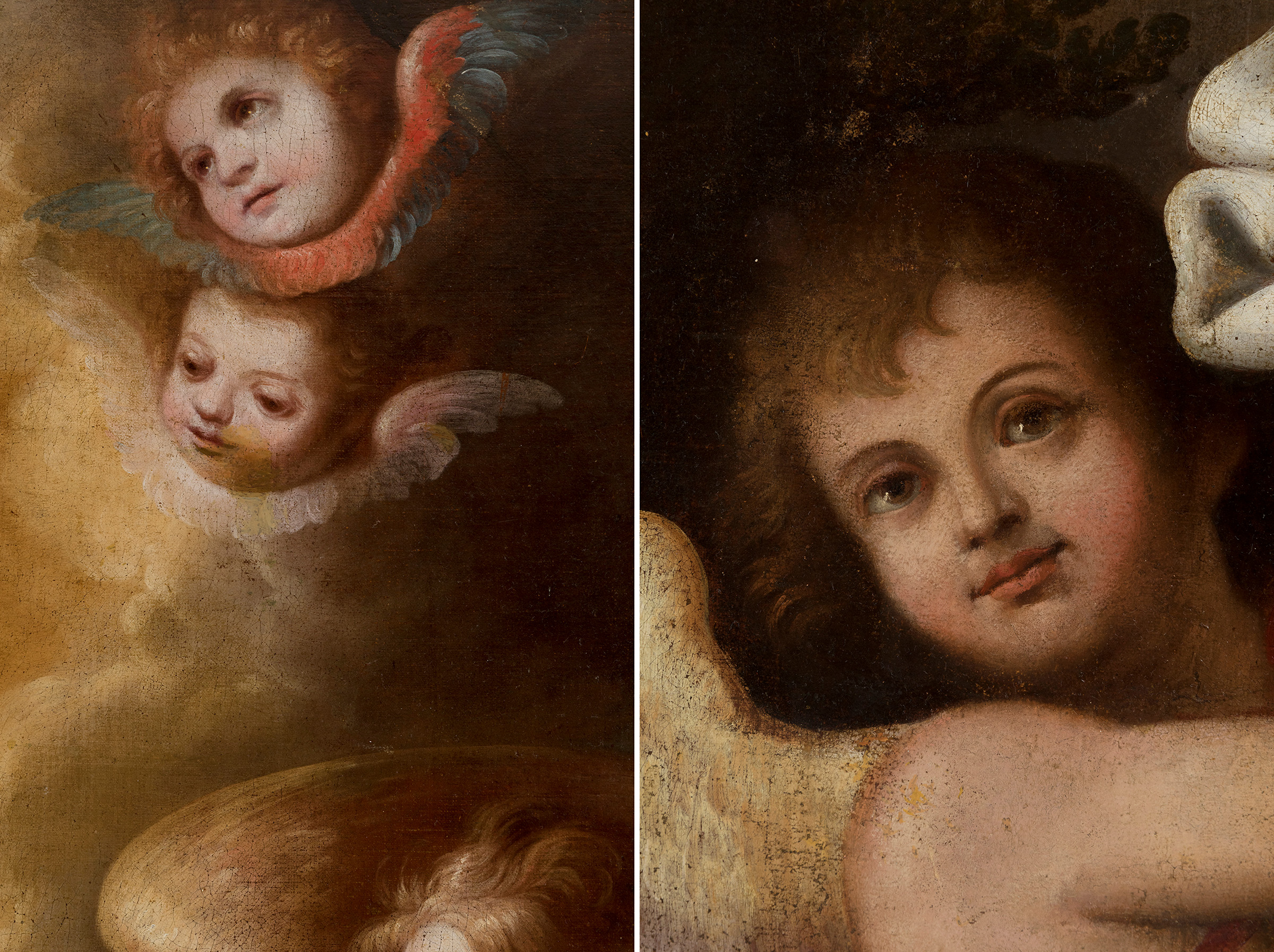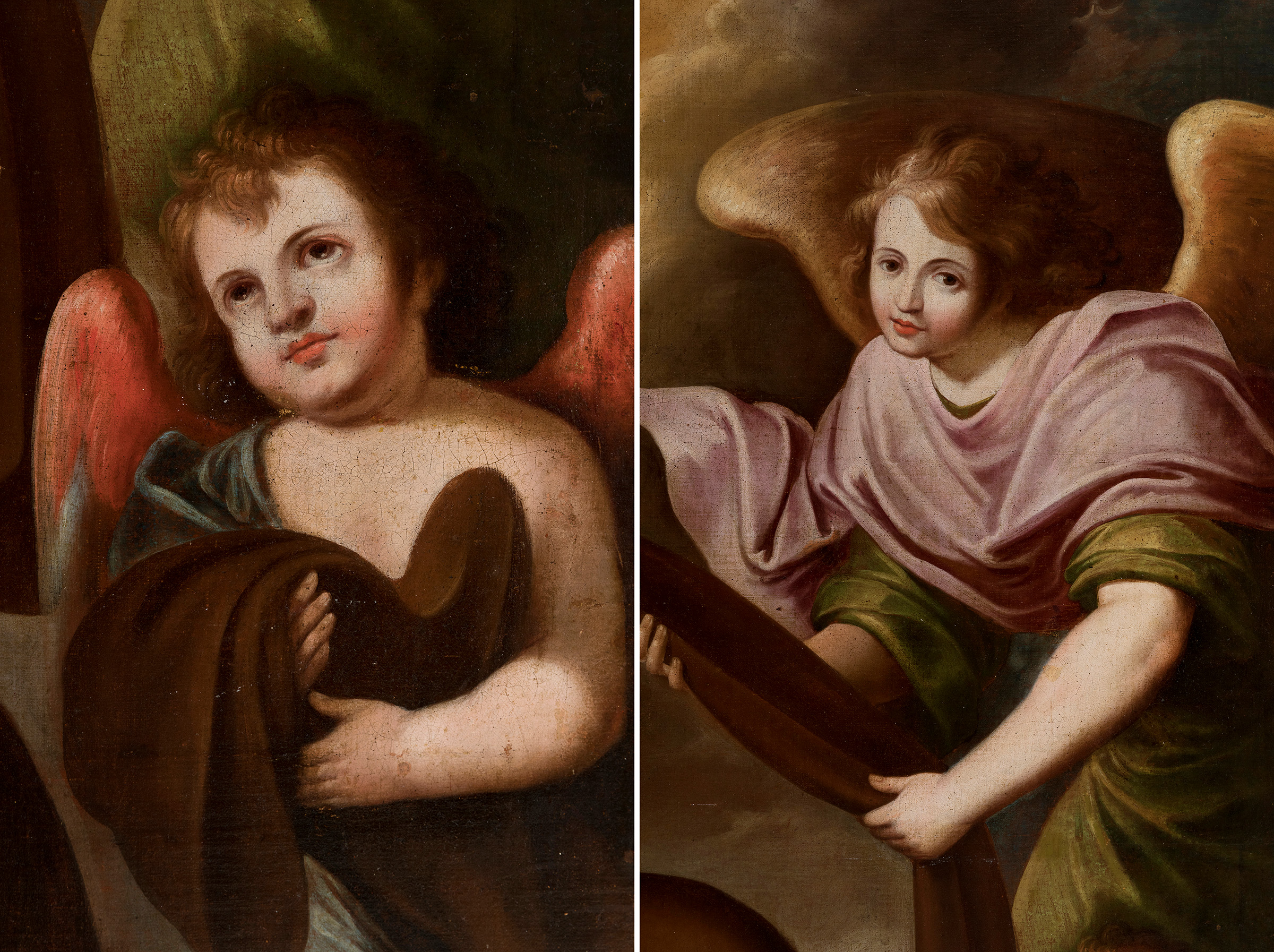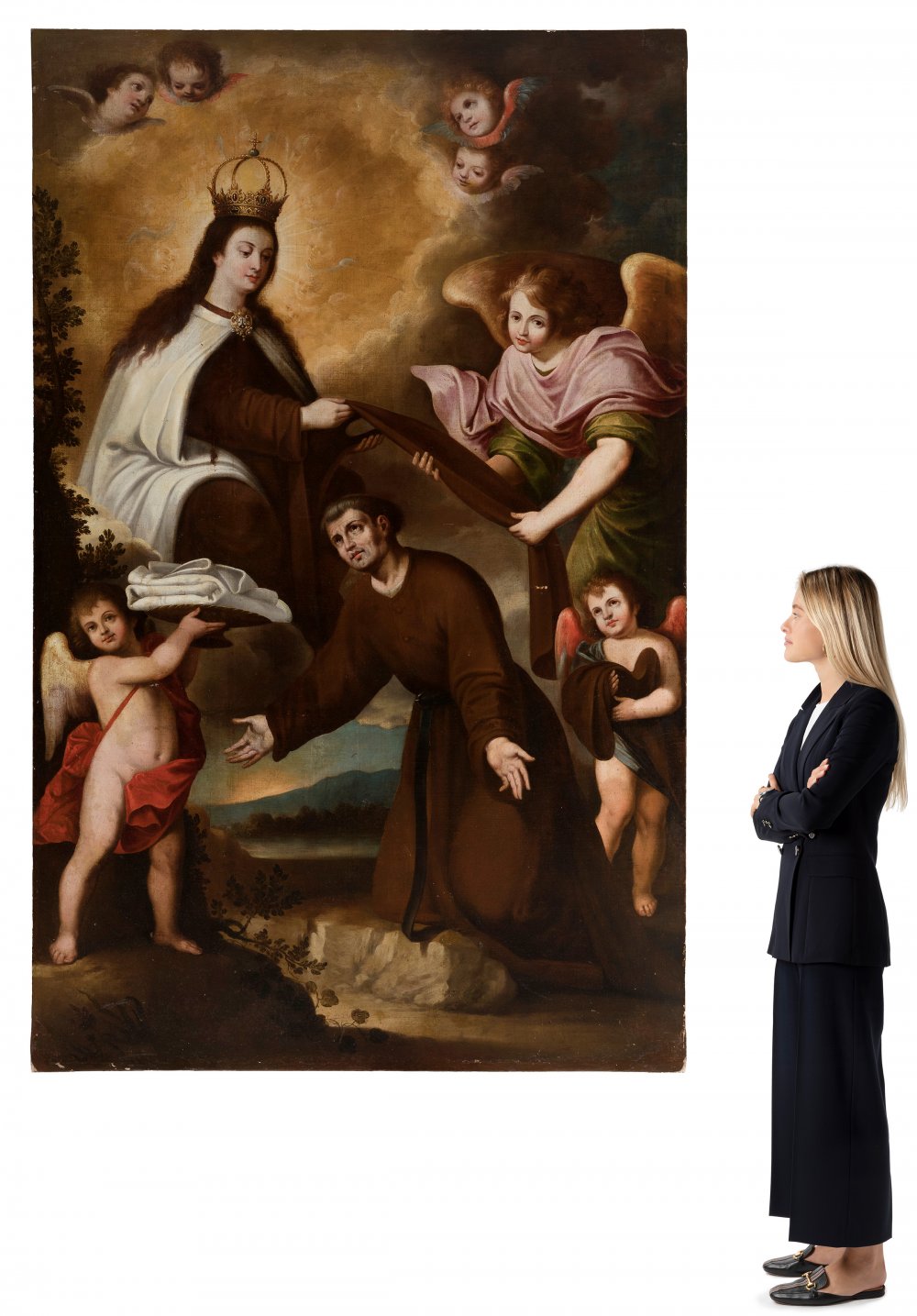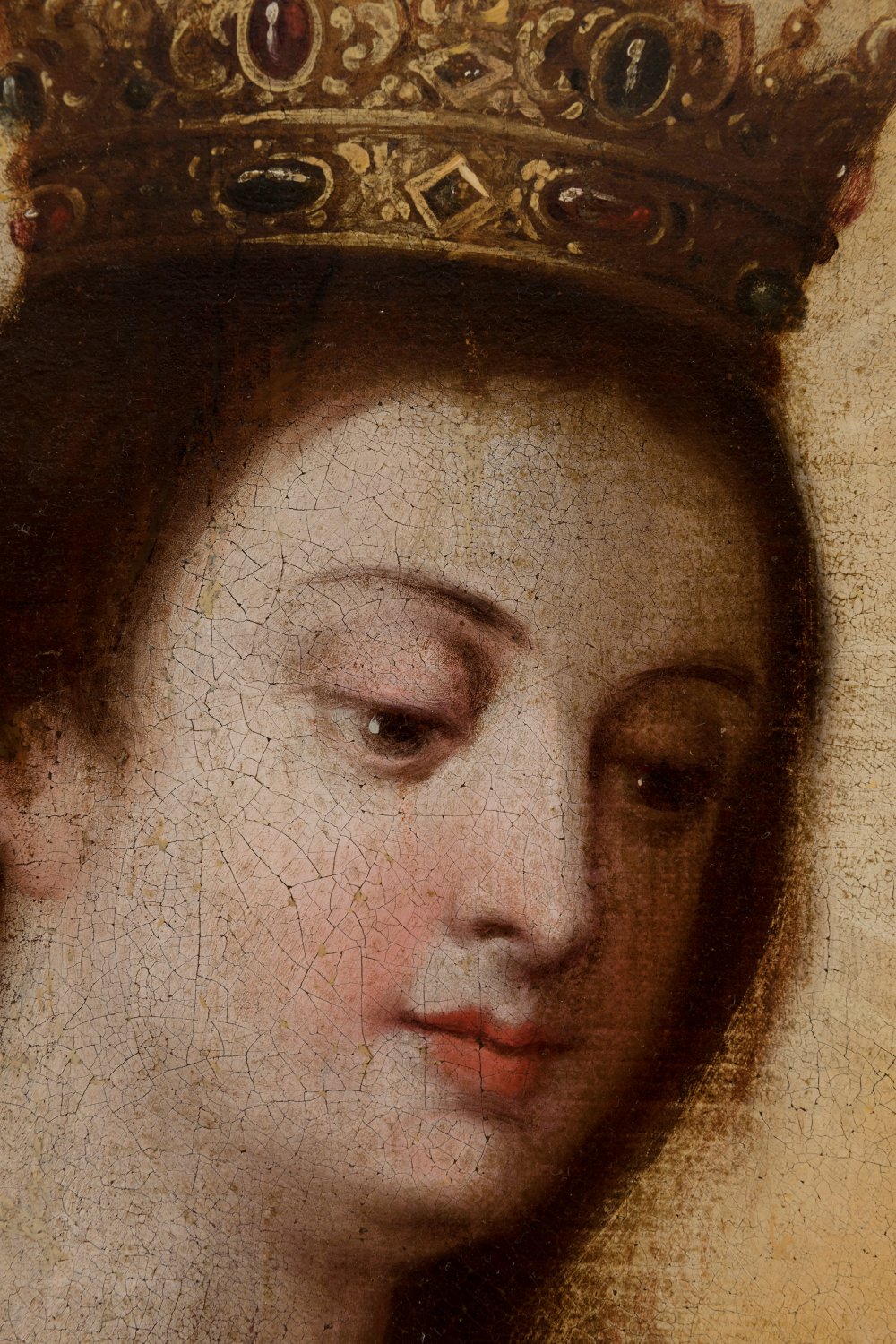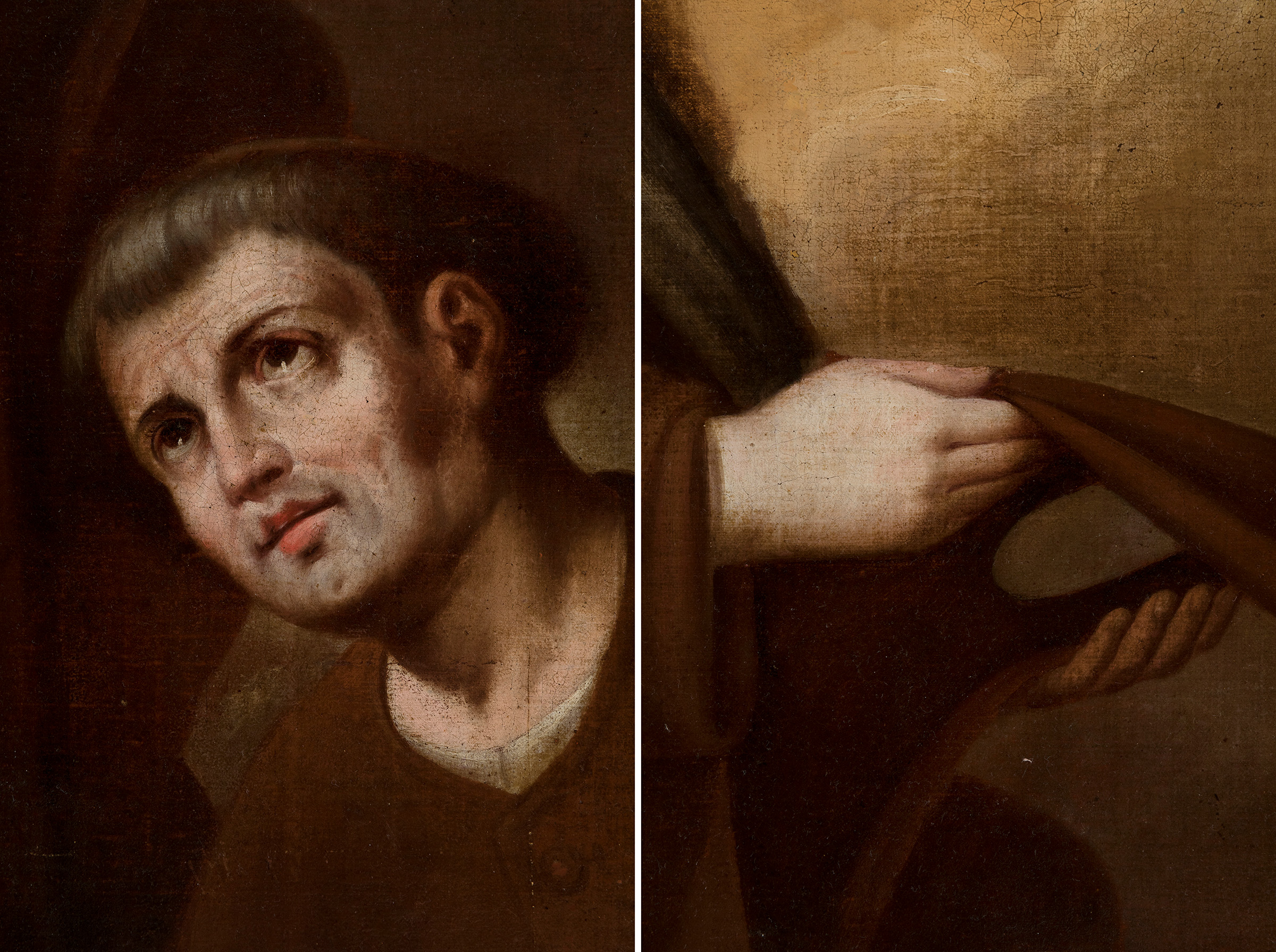9
Sevillian school; 17th century."Virgen del Carmen imposing the chasuble on Simon".Oil on canvas.
1/7
Description
Sevillian school; 17th century.
"Virgen del Carmen imposing the chasuble on Simon".
Oil on canvas. Re-drawn.
It presents faults and restorations on the pictorial surface.
Measurements: 233 x 147 cm.
This canvas represents Saint Simon Stock kneeling before the apparition of the Virgin, surrounded by angels. Mary gives the saint the chasuble, and two angels situated on the earthly plane bring him the priestly habit. The composition is approached from a narrative point of view that seeks to make the scene easy for the faithful to understand, in the Counter-Reformationist naturalistic taste, which is combined with a markedly scenographic space, also typically Baroque. The two main figures appear in the centre of the composition, perfectly emphasised by their position and by the space around them, avoiding excessive spatial tension and focusing the viewer's attention. The scene is set in an exterior dominated in the upper area by the golden splendour of a break of glory, while the lower area is dominated by a landscape. Our Lady of Mount Carmel is named after Mount Carmel in Israel. Tradition has it that during the celebration of Pentecost some of the faithful who were on this mountain were converted to Catholicism after the apparition of the Virgin. There they founded a temple in honour of Mary, the origin of the congregation of the Brothers of St Mary of Mount Carmel, which came to Europe in the 13th century after their persecution in the Holy Land. In 1251, her image is said to have appeared to Saint Simon Stock, superior general of the Order, to whom she gave her habits and the scapular, the main sign of the Carmelite Marian cult, which Mary carries here in her right hand. Tradition has it that Our Lady promised to deliver from Purgatory and take to heaven all souls who wore the scapular during their lifetime, a belief that has been endorsed by the Popes. Saint Simon Stock is therefore one of the central figures in the history of the Carmelite Order. He was elected in 1247 as Prior General of the Carmelites, and four years later the apparition of the Virgin Mary took place in response to his pleas for help for his oppressed order. He was responsible for the structural change of the Carmelites, abandoning their original eremitism and becoming part of the mendicant or apostolic orders. The most reliable source on his life is an old Catalogue of Saints of the order, of which three redactions from the 14th century have been preserved. These contain information such as the fact that his surname, Stock, was due to the fact that he lived in the trunk of a tree.
The 17th century saw the arrival of the Baroque in the Sevillian school, with the triumph of naturalism over Mannerist idealism, a loose style and many other aesthetic liberties. At this time the school reached its greatest splendour, both in terms of the quality of its works and the primordial status of Sevillian Baroque painting. Thus, during the transition to the Baroque period, we find Juan del Castillo, Antonio Mohedano and Francisco Herrera el Viejo, whose works already display the rapid brushstrokes and crude realism of the style, and Juan de Roelas, who introduced Venetian colourism. The middle of the century saw the fullness of the period, with figures such as Zurbarán, a young Alonso Cano and Velázquez. Finally, in the last third of the century we find Murillo and Valdés Leal, founders in 1660 of an Academy where many of the painters active during the first quarter of the 18th century were trained, such as Meneses Osorio, Sebastián Gómez, Lucas Valdés and others.
"Virgen del Carmen imposing the chasuble on Simon".
Oil on canvas. Re-drawn.
It presents faults and restorations on the pictorial surface.
Measurements: 233 x 147 cm.
This canvas represents Saint Simon Stock kneeling before the apparition of the Virgin, surrounded by angels. Mary gives the saint the chasuble, and two angels situated on the earthly plane bring him the priestly habit. The composition is approached from a narrative point of view that seeks to make the scene easy for the faithful to understand, in the Counter-Reformationist naturalistic taste, which is combined with a markedly scenographic space, also typically Baroque. The two main figures appear in the centre of the composition, perfectly emphasised by their position and by the space around them, avoiding excessive spatial tension and focusing the viewer's attention. The scene is set in an exterior dominated in the upper area by the golden splendour of a break of glory, while the lower area is dominated by a landscape. Our Lady of Mount Carmel is named after Mount Carmel in Israel. Tradition has it that during the celebration of Pentecost some of the faithful who were on this mountain were converted to Catholicism after the apparition of the Virgin. There they founded a temple in honour of Mary, the origin of the congregation of the Brothers of St Mary of Mount Carmel, which came to Europe in the 13th century after their persecution in the Holy Land. In 1251, her image is said to have appeared to Saint Simon Stock, superior general of the Order, to whom she gave her habits and the scapular, the main sign of the Carmelite Marian cult, which Mary carries here in her right hand. Tradition has it that Our Lady promised to deliver from Purgatory and take to heaven all souls who wore the scapular during their lifetime, a belief that has been endorsed by the Popes. Saint Simon Stock is therefore one of the central figures in the history of the Carmelite Order. He was elected in 1247 as Prior General of the Carmelites, and four years later the apparition of the Virgin Mary took place in response to his pleas for help for his oppressed order. He was responsible for the structural change of the Carmelites, abandoning their original eremitism and becoming part of the mendicant or apostolic orders. The most reliable source on his life is an old Catalogue of Saints of the order, of which three redactions from the 14th century have been preserved. These contain information such as the fact that his surname, Stock, was due to the fact that he lived in the trunk of a tree.
The 17th century saw the arrival of the Baroque in the Sevillian school, with the triumph of naturalism over Mannerist idealism, a loose style and many other aesthetic liberties. At this time the school reached its greatest splendour, both in terms of the quality of its works and the primordial status of Sevillian Baroque painting. Thus, during the transition to the Baroque period, we find Juan del Castillo, Antonio Mohedano and Francisco Herrera el Viejo, whose works already display the rapid brushstrokes and crude realism of the style, and Juan de Roelas, who introduced Venetian colourism. The middle of the century saw the fullness of the period, with figures such as Zurbarán, a young Alonso Cano and Velázquez. Finally, in the last third of the century we find Murillo and Valdés Leal, founders in 1660 of an Academy where many of the painters active during the first quarter of the 18th century were trained, such as Meneses Osorio, Sebastián Gómez, Lucas Valdés and others.
Auction Details
Shipping
T&Cs & Important Info
Ask seller a question
Sevillian school; 17th century.
"Virgen del Carmen imposing the chasuble on Simon".
Oil on canvas. Re-drawn.
It presents faults and restorations on the pictorial surface.
Measurements: 233 x 147 cm.
This canvas represents Saint Simon Stock kneeling before the apparition of the Virgin, surrounded by angels. Mary gives the saint the chasuble, and two angels situated on the earthly plane bring him the priestly habit. The composition is approached from a narrative point of view that seeks to make the scene easy for the faithful to understand, in the Counter-Reformationist naturalistic taste, which is combined with a markedly scenographic space, also typically Baroque. The two main figures appear in the centre of the composition, perfectly emphasised by their position and by the space around them, avoiding excessive spatial tension and focusing the viewer's attention. The scene is set in an exterior dominated in the upper area by the golden splendour of a break of glory, while the lower area is dominated by a landscape. Our Lady of Mount Carmel is named after Mount Carmel in Israel. Tradition has it that during the celebration of Pentecost some of the faithful who were on this mountain were converted to Catholicism after the apparition of the Virgin. There they founded a temple in honour of Mary, the origin of the congregation of the Brothers of St Mary of Mount Carmel, which came to Europe in the 13th century after their persecution in the Holy Land. In 1251, her image is said to have appeared to Saint Simon Stock, superior general of the Order, to whom she gave her habits and the scapular, the main sign of the Carmelite Marian cult, which Mary carries here in her right hand. Tradition has it that Our Lady promised to deliver from Purgatory and take to heaven all souls who wore the scapular during their lifetime, a belief that has been endorsed by the Popes. Saint Simon Stock is therefore one of the central figures in the history of the Carmelite Order. He was elected in 1247 as Prior General of the Carmelites, and four years later the apparition of the Virgin Mary took place in response to his pleas for help for his oppressed order. He was responsible for the structural change of the Carmelites, abandoning their original eremitism and becoming part of the mendicant or apostolic orders. The most reliable source on his life is an old Catalogue of Saints of the order, of which three redactions from the 14th century have been preserved. These contain information such as the fact that his surname, Stock, was due to the fact that he lived in the trunk of a tree.
The 17th century saw the arrival of the Baroque in the Sevillian school, with the triumph of naturalism over Mannerist idealism, a loose style and many other aesthetic liberties. At this time the school reached its greatest splendour, both in terms of the quality of its works and the primordial status of Sevillian Baroque painting. Thus, during the transition to the Baroque period, we find Juan del Castillo, Antonio Mohedano and Francisco Herrera el Viejo, whose works already display the rapid brushstrokes and crude realism of the style, and Juan de Roelas, who introduced Venetian colourism. The middle of the century saw the fullness of the period, with figures such as Zurbarán, a young Alonso Cano and Velázquez. Finally, in the last third of the century we find Murillo and Valdés Leal, founders in 1660 of an Academy where many of the painters active during the first quarter of the 18th century were trained, such as Meneses Osorio, Sebastián Gómez, Lucas Valdés and others.
"Virgen del Carmen imposing the chasuble on Simon".
Oil on canvas. Re-drawn.
It presents faults and restorations on the pictorial surface.
Measurements: 233 x 147 cm.
This canvas represents Saint Simon Stock kneeling before the apparition of the Virgin, surrounded by angels. Mary gives the saint the chasuble, and two angels situated on the earthly plane bring him the priestly habit. The composition is approached from a narrative point of view that seeks to make the scene easy for the faithful to understand, in the Counter-Reformationist naturalistic taste, which is combined with a markedly scenographic space, also typically Baroque. The two main figures appear in the centre of the composition, perfectly emphasised by their position and by the space around them, avoiding excessive spatial tension and focusing the viewer's attention. The scene is set in an exterior dominated in the upper area by the golden splendour of a break of glory, while the lower area is dominated by a landscape. Our Lady of Mount Carmel is named after Mount Carmel in Israel. Tradition has it that during the celebration of Pentecost some of the faithful who were on this mountain were converted to Catholicism after the apparition of the Virgin. There they founded a temple in honour of Mary, the origin of the congregation of the Brothers of St Mary of Mount Carmel, which came to Europe in the 13th century after their persecution in the Holy Land. In 1251, her image is said to have appeared to Saint Simon Stock, superior general of the Order, to whom she gave her habits and the scapular, the main sign of the Carmelite Marian cult, which Mary carries here in her right hand. Tradition has it that Our Lady promised to deliver from Purgatory and take to heaven all souls who wore the scapular during their lifetime, a belief that has been endorsed by the Popes. Saint Simon Stock is therefore one of the central figures in the history of the Carmelite Order. He was elected in 1247 as Prior General of the Carmelites, and four years later the apparition of the Virgin Mary took place in response to his pleas for help for his oppressed order. He was responsible for the structural change of the Carmelites, abandoning their original eremitism and becoming part of the mendicant or apostolic orders. The most reliable source on his life is an old Catalogue of Saints of the order, of which three redactions from the 14th century have been preserved. These contain information such as the fact that his surname, Stock, was due to the fact that he lived in the trunk of a tree.
The 17th century saw the arrival of the Baroque in the Sevillian school, with the triumph of naturalism over Mannerist idealism, a loose style and many other aesthetic liberties. At this time the school reached its greatest splendour, both in terms of the quality of its works and the primordial status of Sevillian Baroque painting. Thus, during the transition to the Baroque period, we find Juan del Castillo, Antonio Mohedano and Francisco Herrera el Viejo, whose works already display the rapid brushstrokes and crude realism of the style, and Juan de Roelas, who introduced Venetian colourism. The middle of the century saw the fullness of the period, with figures such as Zurbarán, a young Alonso Cano and Velázquez. Finally, in the last third of the century we find Murillo and Valdés Leal, founders in 1660 of an Academy where many of the painters active during the first quarter of the 18th century were trained, such as Meneses Osorio, Sebastián Gómez, Lucas Valdés and others.
29th December - Old Masters
Sale Date(s)
Venue Address
Aragón 346, Barcelona
Calle Velázquez 7, Madrid
Carrer de Cirilo Amorós 55, Valencia
Barcelona
08009
Spain
General delivery information available from the auctioneer
Setdart offers Worldwide shipping
PICK UP IN ROOM: You can come and pick up your lots in our offices (Barcelona, Madrid or Valencia). At the moment of the withdrawal, you will be able to accept the current conditions of the lot by means of a document that you will sign.
YOU CAN SEND ANOTHER PERSON TO PICK UP: This person must present a signed authorization that you can find in our web page by accessing from BUY AT SETDART- LOGISTICS-DOWNLOAD AUTHORIZATION DOCUMENT. You can also send an e-mail with the requested data in AUTHORIZATION DOCUMENT to admin@setdart.com
Important Information
25% buyer´s premium
21% buyer´s premium at www.setdart.com















